Blog
Michelle Macauley announces the formation of Macauley Trenchless, PLLC

Michelle Macauley brings over two decades of experience as a geotechnical engineer and as a subject matter expert in trenchless technology for water and wastewater conveyance projects. Joining Michelle as her operations manager and as a soon-to-be-certified Project Management Professional (PMP) is Jeff Macauley. Jeff is an army special operations combat veteran bringing over 25 years of experience in risk identification, risk mitigation and project management.
Michelle has more than 21 years of experience in geotechnical engineering, with a particular emphasis on trenchless design and involvement in the water/wastewater industry. Prior to starting Macauley Trenchless, Michelle was the National Trenchless Practice Lead for Jacobs Engineering and oversaw multiple trenchless projects across the company. Prior to working at Jacobs, Michelle was a senior geotechnical engineer specializing in trenchless design and construction with other Pacific Northwest geotechnical and trenchless design firms. Her trenchless expertise includes horizontal directional drilling, microtunneling, pipejacking, auger-boring, pipe ramming, pilot-tube microtunneling, and other technologies. In addition to her extensive project experience, she has been active in the North American Society for Trenchless Technology (NASTT), is currently serving on the Board of Directors for NASTT, and is a regular presenter at national trenchless conferences.
“I am so excited to begin a business pursuing my passion helping people evaluate the risks and benefits associated with trenchless design and construction.”
For further information please contact:
Michelle Macauley – michelle@macauleytrenchless.com
Jeff Macauley – jeff@macauleytrenchless.com
Blog, Industry News, trenchless people
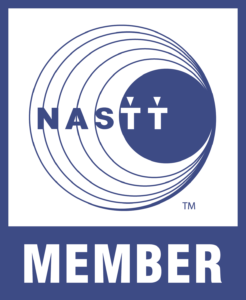 NASTT is pleased to present three new membership opportunities in 2018:
NASTT is pleased to present three new membership opportunities in 2018:
Attention Students!
Available now: Student Non-Affiliated Membership
NASTT proudly engages 18 official Student Chapters,and now we are branching out to all students throughout North America! The NASTT Student Non-Affiliated Membership ($50 USD per year) is available to any student actively enrolled full-time in a North American university that doesn’t currently have an official Student Chapter on campus.
Overseas Opportunities!
Available now: International Individual Membership
The NASTT International Individual Membership ($250 USD per year) is available to any individual residing outside of North America.
Stay Engaged!
Available now: Retiree Membership
The NASTT Retiree Membership ($40 USD per year) is open to NASTT members after they retire from the industry.
Click here to learn about all of NASTT’s membership options.
Blog, Industry News
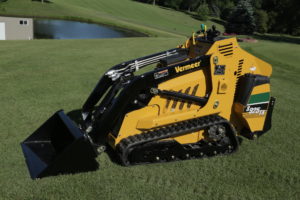 Delivering Outstanding Lifting and Hydraulic Performances
Delivering Outstanding Lifting and Hydraulic Performances
PELLA, Iowa, November 1, 2017 – Vermeer has expanded its compact equipment lineup with the new S925TX mini skid steer, designed to provide impressive lifting performance and the power to conquer the most demanding applications.
With a tip capacity of 2,643 pounds (1,198.8 kg), a rated operating capacity of 925 pounds (419.6 kg) and maximum hinge pin height reach of 84.5 inches (214.6 cm), the radial lift path of the Vermeer S925TX makes easy work of lifting and dumping heavy loads.
The new mini skid steer features a dual auxiliary system which allows the operator to switch between high flow for ground-engaging attachments and low flow for maximum control. It is also equipped with a universal mounting plate that fits a broad range of Vermeer-approved attachments.
“From landscaping and tree care to rental operations, contractors are discovering that Vermeer mini skid steers can increase their daily productivity,” said Jon Kuyers, senior global products manager at Vermeer. “With the S925TX model, we’ve designed a machine that can deliver a higher lifting performance than most other machines in the compact utility loader segment while still maintaining a compact size and impressive hydraulic attachment wielding performance.”
The new Vermeer S925TX mini skid steer is offered in three smooth-running, high-torque, four-cylinder engine options, including a 24.8 hp (18.2 kW) Kubota V1505 diesel engine, a 40 hp (29.8 kW) Kubota WG1605 gas engine and the 35.1 hp (26.2 kW) Kubota V1505 diesel engine offered only for international markets. Contractors can further customize their mini skid steer loader with either 7-inch (17.8 cm) wide tracks that produce 5 psi (.4 bar) of ground pressure or 9-inch (22.9 cm) wide tracks with 4 psi (.3 bar) of ground pressure for even better floatation.
The S925TX mini skid steer has a travel speed of 4.1 mph (6.6 km/h). Like other Vermeer mini skid steers, the S925TX is built with a chariot-style platform for optimum operator comfort, and pilot-operated ground drive to help the user maintain smooth control on the jobsite, as well as in tight areas.
The Vermeer S925TX is backed by a three-year/3000-hour extended limited warranty on the mainframe and loader arms for even more assurance and piece-of-mind on the job.
For more information about the Vermeer S925TX mini skid steer, contact your local Vermeer dealer or visit Vermeer.com.
Blog, Industry News, trenchless products
XL-I Series Hole Openers Are Designed From the Ground Up For HDD
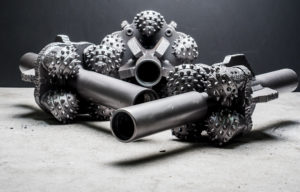 (Hutchinson, Kansas) – StraightLine HDD recently expanded its hole opener offering with the introduction of the XL-I Series. Designed from the ground up for horizontal directional drilling, the XL-I Series is positioned as a cost-effective alternative to “split-bit” hole openers.
(Hutchinson, Kansas) – StraightLine HDD recently expanded its hole opener offering with the introduction of the XL-I Series. Designed from the ground up for horizontal directional drilling, the XL-I Series is positioned as a cost-effective alternative to “split-bit” hole openers.
At the core of the design are proprietary cones—available in six sizes, in either Tungsten Carbide or Mill Tooth configurations. Mounted to a purpose-built platform, the design facilitates load transfer to the shaft and bearing, with minimal radial load. The result is a dramatic improvement in production, service life and consistency, bore after bore.
Next, designers set out to address wear and performance characteristics by re-examining the interplay between cone diameter, height and carbide placement. Cones are sized and attached to the baseplate at an angle that protects vulnerable surfaces. Shortened cone height further improves wear resistance. Carbides placed to cut independent paths yield higher efficiency and longer service life.
Internally, the cone’s proprietary sealing and bearing system mitigates fluid intrusion, yielding a myriad of user benefits, from reduced torque and fuel consumption to extended tool life.
As a platform, the XL-I Series incorporates design characteristics that ensure the tool’s original geometry is maintained—even after rebuild. This approach yields consistent and repeatable performance.
The XL-I Series includes six sizes, from 12.75- to 24-inches with IF Box x Box shafts.
About StraightLine HDD
Since 1984, StraightLine has produced drilling solutions” to the trenchless industry. It’s full line of down-hole tools, wear parts and accessories are known for their innovative and rugged design. The portfolio now includes the full array of hard condition tools under the Armadrillco brand. In 2015, StraightLine HDD merged operations with Source: HDD, Inc., a leading provider of used HDD rigs and support equipment. Together, the merger created a company offering total HDD solutions—from rig to bit. Call 620.802.0200 or visit www.straightlinehdd.com for details.
Blog, trenchless people
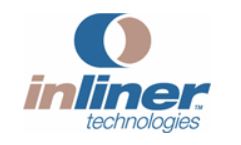 We are proud to spotlight NASTT’s 2017 No-Dig Show Silver Sponsor, Inliner.
We are proud to spotlight NASTT’s 2017 No-Dig Show Silver Sponsor, Inliner.
Inliner Technologies, LLC was established to manage, promote and continue to develop the CIPP technologies used by the Inliner® network of installers. Inliner® was first introduced to the United States in 1989 by the Kanal-Müeller Gruppe International, a German company who had been installing the product in Europe since 1985. In 1991, Reynolds Inc., a large Midwestern water and wastewater contractor decided to add the process of installing Cured-in-Place pipe (CIPP) to their roster of services as an Inliner® licensee soon to be joined by Kenny Construction Company, Lametti & Sons, and Western Slope Utilities,and finally, Clean Water Works, Inc. in the network of Inliner installers. In 1999, Reynolds Inc. would purchase the technology and rights to license the Inliner® process establishing Inliner Technologies,LLC as the technology and licensing company and Liner Products, LLC, the liner manufacturing company, both headquartered in Paoli, Indiana.
In 2005, Reynolds, Inc. was acquired by Layne, and as a result, Inliner Technologies and Liner Products, LLC are now part of the Layne corporate structure. With a successful track record since 1989, the sustained growth of the network has led to the current organization of certified installers consisting of over 40 crews, who together have installed over 25 million feet of Cured-in-place pipe. This organization shares in the development of improved processes, materials and most recently the introduction of a UV-Cured product known as Inliner STX.
Inliner Technologies is an industry leader in Cured-in-Place pipe renewal (CIPP), and offers trenchless pipeline rehabilitation solutions to municipal and industrial clients looking for safe, cost-effective, and long-term solutions for their aging infrastructure needs.
Inliner® Cured-in-Place pipe (CIPP) product has been used throughout the U.S. and Canada to protect, seal and renew over 25 million feet of sanitary, storm and industrial process piping.
Blog, Industry News, trenchless projects
Custom Robbins Machine finishes on a High Note under Low Cover
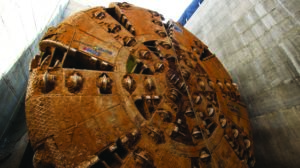 On June 8, 2017, a select group of project officials, including Mexico’s President Enrique Peña Nieto, celebrated the final breakthrough of an epic tunneling project. The 8.7 m (28.5 ft) diameter Robbins Crossover TBM is the first such hybrid machine to operate in North America, and it completed the Túnel Emisor Poniente (TEP) II on a high note. The TBM, known an XRE—a Crossover (X) between Rock (R) and EPB (E) TBMs—navigated fault zones, variable ground, low cover, and more to achieve a national record of 57 m (187 ft) in one day as well as maximum rates of 231 m (758 ft) in one week and 702 m (2,303 ft) in one month.
On June 8, 2017, a select group of project officials, including Mexico’s President Enrique Peña Nieto, celebrated the final breakthrough of an epic tunneling project. The 8.7 m (28.5 ft) diameter Robbins Crossover TBM is the first such hybrid machine to operate in North America, and it completed the Túnel Emisor Poniente (TEP) II on a high note. The TBM, known an XRE—a Crossover (X) between Rock (R) and EPB (E) TBMs—navigated fault zones, variable ground, low cover, and more to achieve a national record of 57 m (187 ft) in one day as well as maximum rates of 231 m (758 ft) in one week and 702 m (2,303 ft) in one month.
“The XRE has a great advantage as it is designed to work in open and/or closed mode (EPB); allowing it to excavate the tunnel either in soil or in rock. We’ve verified that its performance was very efficient,” said Ing. Juan Alberto Herrera Moro y Castillo, TEP II Section Chief for owner CONAGUA, Mexico’s National Water Commission.
The unique machine and its Robbins continuous conveyor system were built on location using Onsite First Time Assembly (OFTA), and designed for a contractor consortium of Aldesem, Proacon, and Recsa. The Robbins XRE TBM featured components like a convertible cutterhead with interchangeable cutting tools, interchangeable TBM belt conveyor and screw conveyor, and multi-speed gearboxes to increase torque for tunneling through difficult ground. “The benefits of the design are in its exceptional thrust power and in the ease of changing the cutterhead torque. This makes the process much easier should the machine become stuck in difficult ground,” said Alberto Martinez, head of the tunneling department for RECSA.
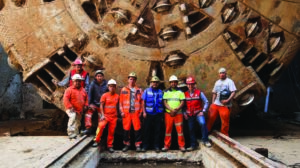 The XRE machine was launched in August 2015 to bore the 5.8 km (3.6 mi) long wastewater tunnel. The machine was set up in a hard rock configuration and mounted with 20-inch diameter disc cutters. Early in 2016 the TBM hit the first of several contact zones, a 30 m (98.4 ft) wide fault of fractured and blocky rock. While the excavation through the contact zone was slow going, progress picked up again in the more competent andesite rock. After an intermediate breakthrough in March 2016 into an 80 m (262.5 ft) deep shaft followed by inspection and maintenance, the TBM continued on.
The XRE machine was launched in August 2015 to bore the 5.8 km (3.6 mi) long wastewater tunnel. The machine was set up in a hard rock configuration and mounted with 20-inch diameter disc cutters. Early in 2016 the TBM hit the first of several contact zones, a 30 m (98.4 ft) wide fault of fractured and blocky rock. While the excavation through the contact zone was slow going, progress picked up again in the more competent andesite rock. After an intermediate breakthrough in March 2016 into an 80 m (262.5 ft) deep shaft followed by inspection and maintenance, the TBM continued on.
While boring in fractured andesite rock in autumn 2016, the TBM encountered a naturally occurring cavern believed to be the result of either a rock fall in a transition zone, or an old, underground lake body that had eroded the rock away. The cavern was estimated at 90 cubic meters (3,200 cubic ft) in size, including about 57 cubic meters (2,010 cubic ft) of unstable floor area. The TBM was stopped and immediate measures were taken to stabilize the ground in front of the machine with polyurethane foam before filling the cavern with a mixture of pea gravel and grout.
By the end of October 2016, the TBM had reached a final 900 m (2,950 ft) long section of soft ground, where it was converted to EPB mode. In this final reach of tunnel with low cover, the distance from the top of the tunnel to residential home foundations was as low as 4 m (13 ft), and the ground had the consistency of reconsolidated soil. In order to stabilize the soft soils and minimize the risk of settlement below the residential area, the tunneling crew drilled from the surface and installed 890 micro-piles at 1.0 m (3.3 ft) intervals. “We were able to do this without causing damage to property owned by neighbors in the zone bordering the path of TEP II, or to the road or the urban infrastructure installed in that area,” explained Ing. Francisco Miguel Lopez, Jobsite Manager TEP II for contractor Aldesa.
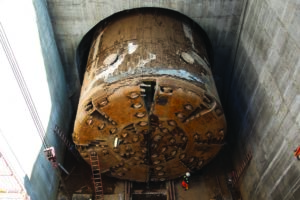 Now that tunneling is complete, the tunnel will receive a secondary concrete lining of 35 cm (14 in) thickness before going into service. The wastewater tunnel will overhaul the current system in western areas outside of Mexico City and serve to prevent recurrent flooding in Valle Dorado. In particular, the tunnel will benefit the cities of Cuautital Izcalli, Tlalnepantla, and Atizapan de Zaragoza, which altogether are home to 2.1 million inhabitants.
Now that tunneling is complete, the tunnel will receive a secondary concrete lining of 35 cm (14 in) thickness before going into service. The wastewater tunnel will overhaul the current system in western areas outside of Mexico City and serve to prevent recurrent flooding in Valle Dorado. In particular, the tunnel will benefit the cities of Cuautital Izcalli, Tlalnepantla, and Atizapan de Zaragoza, which altogether are home to 2.1 million inhabitants.
Image 1: The 8.7 m (28.5 ft) diameter Robbins XRE TBM was the first Crossover machine to bore in North America.
Image 2: Robbins personnel stand proudly in front of the Crossover TBM for Túnel Emisor Poniente (TEP) II—the project resulted in challenges as well as national records for TBM advance.
Image 3: During its bore, the Crossover achieved a national record for TBM advance, excavating 57 m (187 ft) in one day as well as achieving high rates of 231 m (758 ft) in one week and 702.2 m (2,303 ft) in one month.








